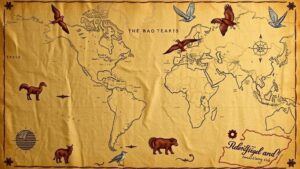Understanding How Natural Land Features Were Incorporated in Maps
Understanding How Natural Land Features Were Incorporated in Maps
The incorporation of natural land features in maps is a crucial aspect of cartography, guiding both practical navigation and the understanding of geographic relationships. From ancient times until today, various techniques have been employed to represent the physical characteristics of landscapes. This article delves into the history, methods, and significance of how natural features are depicted on maps, highlighting their importance in a variety of fields such as geography, urban planning, and environmental science.
The Historical Context of Mapping Natural Features
Historically, maps were essential for navigation and territorial representation. Early cartographers, working with limited technology and knowledge, sought to represent land features accurately. Ancient civilizations like the Greeks and Romans created maps that often included mountains, rivers, and forests. For example, Ptolemys Geographia, written in the 2nd century AD, provided a systematic approach to mapmaking that relied heavily on the observation of natural features such as the Nile and the Mediterranean Sea.
Throughout the Middle Ages, mapmaking was influenced by religious and cultural understanding, leading to maps that frequently employed symbols rather than accurate representations of the physical world. But, as Europe entered the Renaissance, interest in scientific exploration led to more precise methods of mapping using instruments like the astrolabe and compasses. These innovations allowed cartographers to incorporate physical features more accurately into their maps.
Techniques for Mapping Natural Land Features
The methods for incorporating natural land features into maps have evolved significantly over the centuries. Today’s techniques can be categorized into several approaches:
- Relief representation: Techniques such as contour lines, shading, and 3D representations are commonly used to depict elevations like mountains and valleys. Contour lines connect points of equal elevation, giving a clear visual representation of terrain.
- Topographic mapping: This involves detailed mapping that includes both natural and artificial features. For example, the United States Geological Survey (USGS) employs topographic maps that reflect both elevation and land use.
- Thematic mapping: This method focuses on specific themes, such as climate or vegetation, allowing for a different representation of natural features based on the purpose of the map. An example is environmental maps that highlight ecosystems and their distributions.
With the advent of Geographic Information Systems (GIS), the precision and accessibility of mapping have improved vastly. GIS enables the layering of data, allowing users to visualize interactions between various natural features and human activity. For example, when assessing flood risks, GIS can overlay maps of river paths with elevation data to identify vulnerable areas.
Case Studies: Mapping Natural Land Features
Two notable case studies illustrate the importance of incorporating natural land features in maps:
- The Lewis and Clark Expedition: In the early 1800s, Meriwether Lewis and William Clark explored the American West, creating maps that recorded their observations of natural features like mountains, plains, and rivers. Their detailed accounts and maps significantly contributed to American exploration and settlement, providing crucial information for future expeditions and land claims.
- The Military Use of Topographic Maps: Military operations have historically depended heavily on accurate maps. During World War II, for example, the Allies utilized detailed topographic maps to plan invasions, such as the Normandy landings, where understanding the terrain proved critical for successful operations.
Implications of Natural Features in Modern Mapping
Today, mapping natural features goes beyond navigation–it influences environmental management, urban development, and disaster response. For example, urban planners utilize topographical maps to assess land suitability for development, considering factors like slope and drainage patterns to prevent flooding.
Also, environmental scientists use maps to monitor changes in natural landscapes, such as deforestation or erosion. By analyzing maps over time, they can effectively communicate issues related to climate change and biodiversity loss to policymakers and the public.
Conclusion and Actionable Takeaways
The incorporation of natural land features in maps is a fundamental aspect of geography that continues to evolve with advancements in technology. Understanding how these features are represented not only enhances navigation but also informs critical real-world applications across various disciplines.
To leverage mapping effectively in your field:
- Familiarize yourself with GIS software to enhance your mapping skills.
- Stay informed about changes in land use and environmental data that can affect natural features over time.
- Engage with interactive maps and online resources to visualize and analyze geographic data relevant to your interests.


